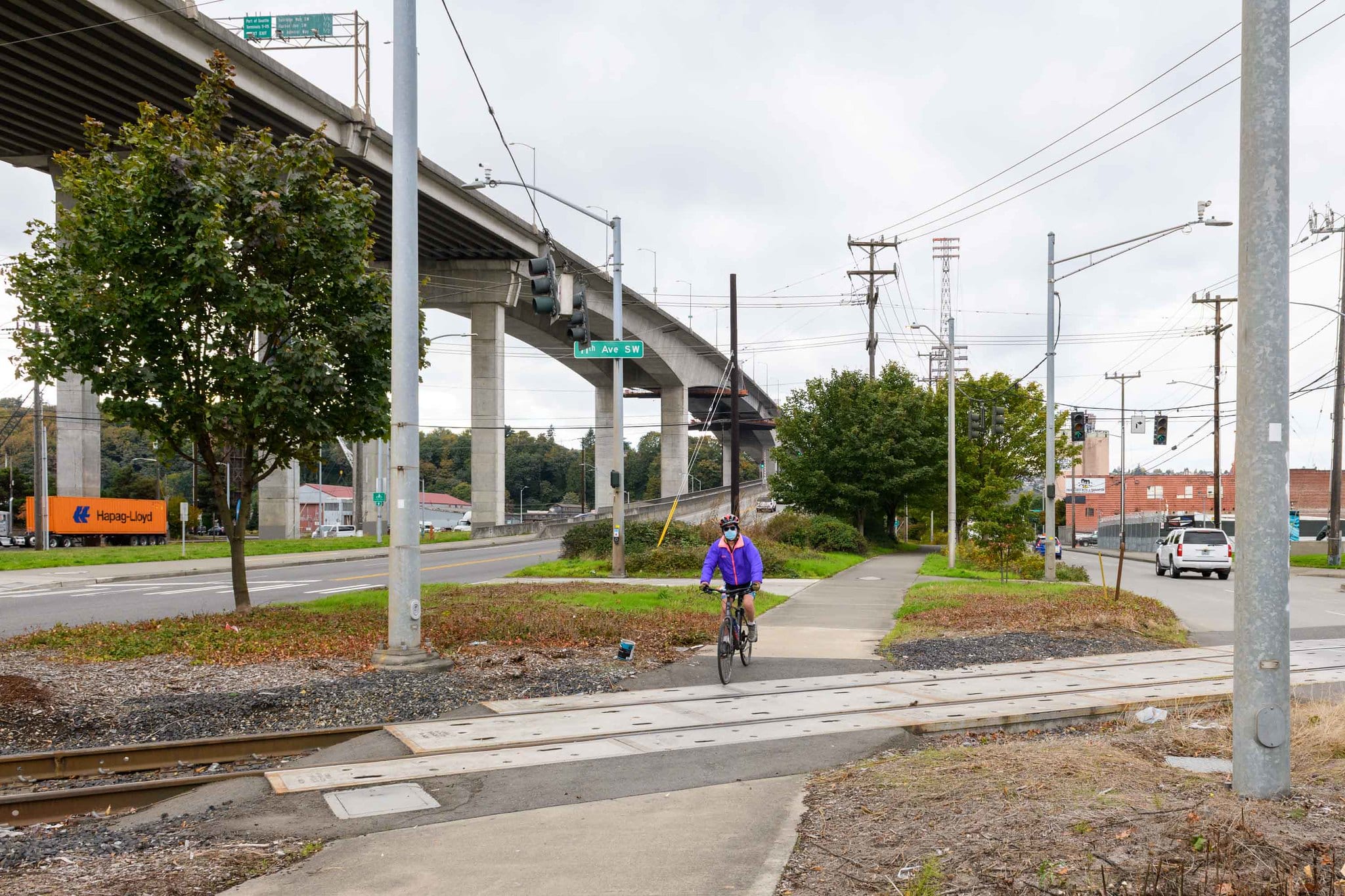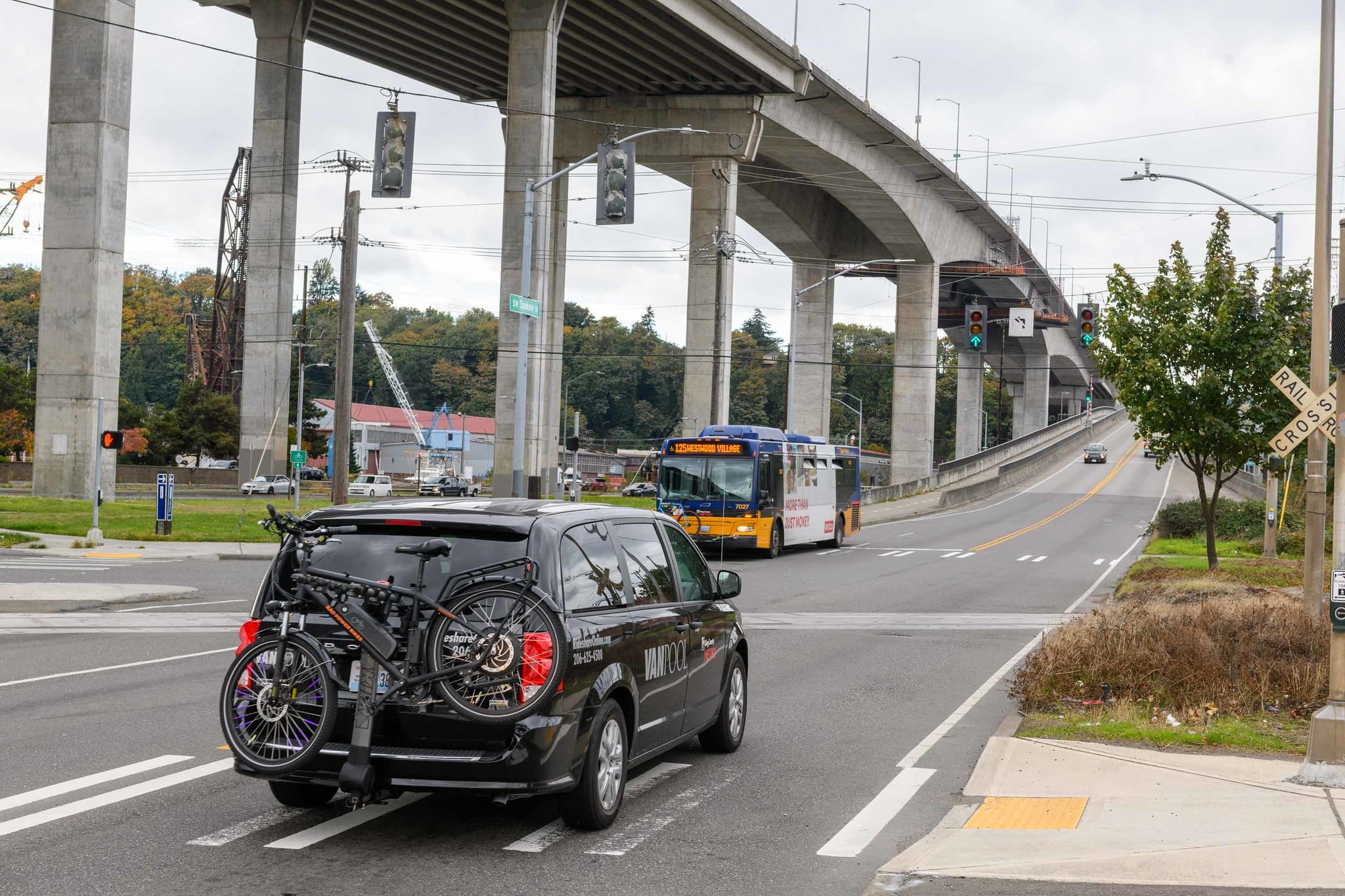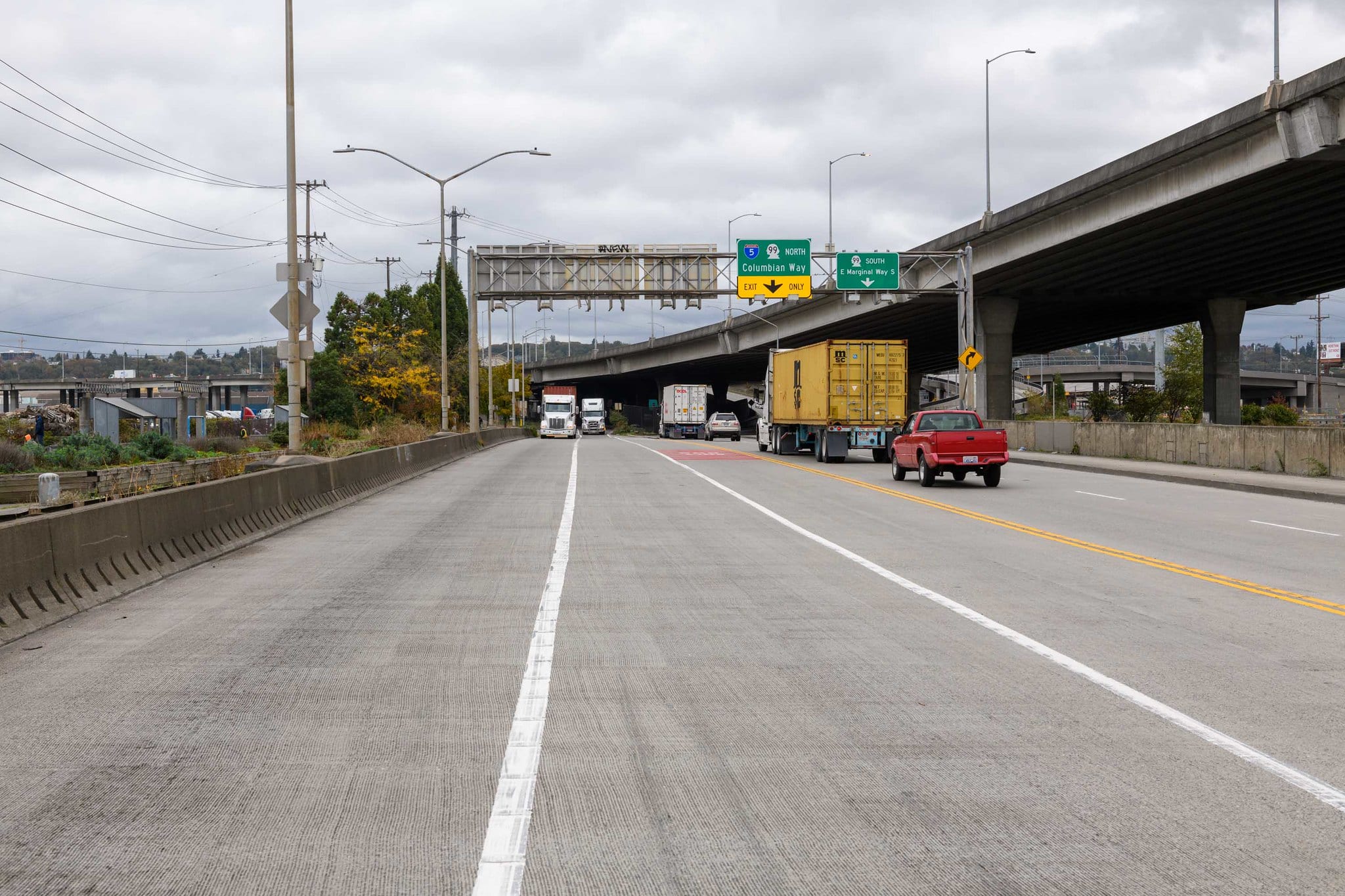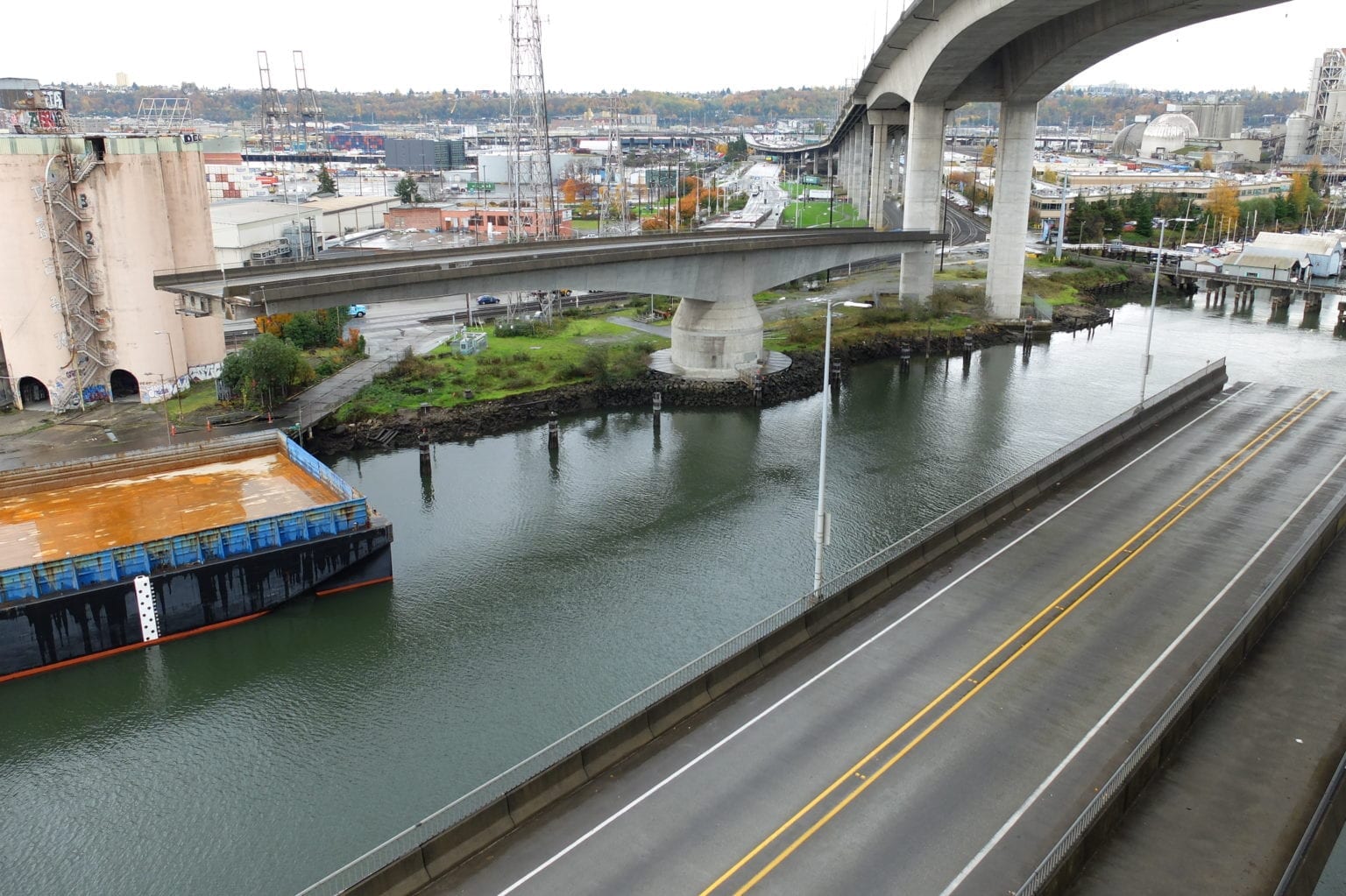 West Seattle Low Bridge, also known as Spokane St Swing Bridge, open for marine traffic.
West Seattle Low Bridge, also known as Spokane St Swing Bridge, open for marine traffic. IMPORTANT NOTE
An earlier version of this blog post noted that warnings would begin as early as December 1, 2020 and monetary violations will begin as early as January 1, 2021. We have updated this blog to reflect that the automated enforcement system will be activated in early January and will include warning notices as well as monetary citations. These updates have been directly reflected below. Text from the earlier version has been indicated with a strikethrough for reference.
We will share detailed timelines in the coming weeks.
Summary

- From approximately October 24 to the end of October, we’re installing signs near the West Seattle Low Bridge on SW Spokane Street.
- The signs will notify people driving that we’re using automated (photo) enforcement on the Low Bridge. Cameras will be installed
in Novemberthe week of December 7. - Low Bridge access is currently for authorized users only and this policy will continue, though it will now rely on 24/7 automated enforcement. The automated enforcement system will use photographs of license plates to identify unauthorized Low Bridge users.
Until as early as January 1, 2021, Through December and into early 2021 when the automated enforcement system is activated, Seattle Police Department (SPD) will continue enforcing existing Low Bridge access restrictions in person.Unauthorized users will be sent non-monetary warnings from as early as December 1-31, 2020. The automated enforcement system will be activated in early January and will include warning notices as well as monetary citations. We will share detailed timelines in the coming weeks.- Starting
as early as January 1,in January 2021, SPD (through the new automated camera enforcement system) will issue $75 citations to unauthorized users. - The warnings and citations will be mailed to the vehicle owner within 14 days of the violation.
- The Low Bridge Access Subcommittee of the Community Task Force will continue to inform how we allocate limited space on the Low Bridge to various types of users.
- We’ll continue communication about Low Bridge automated enforcement with more specific updates before warnings and citations begin.
Automated enforcement was approved by the Seattle City Council and will optimize Low Bridge usage and ensure safe access for emergency vehicles.
Note: The below timeline image has been revised from the original.
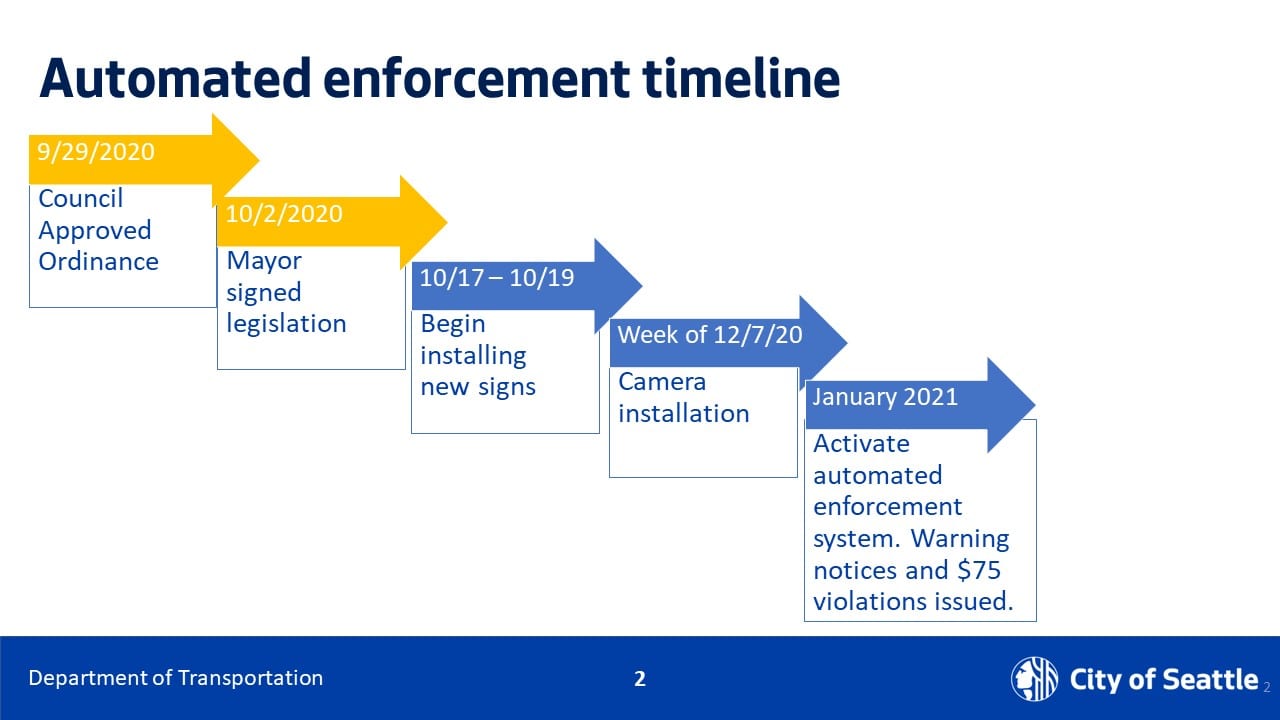
On September 29, 2020, Seattle City Council approved automated enforcement for the Low Bridge.
Specifically, this means that SDOT has authority to use cameras on the Low Bridge through this Ordinance (119897) establishing additional uses for automated traffic safety cameras to reduce traffic congestion and increase safety. This amended Sections 11.31.090 and 11.50.570 of the Seattle Municipal Code.
Automated enforcement on the Low Bridge allows us to better enforce the Low Bridge access policy by recognizing in real-time authorized users like transit vehicles, school buses, freight vehicles, emergency response vehicles, and potentially a small number of additional authorized users, to be identified through the Low Bridge Access Subcommittee.
To date, in an effort to ensure traffic volumes do not impact emergency vehicle response times as we develop our automated enforcement system and policies, Seattle Police Department (SPD) officers have been ticketing or turning around people using the Low Bridge during AM and PM peak commute hours. Enforcement by SPD alone is temporary until we implement automated enforcement, but SPD Traffic or Patrol officers, as well as other localized police agencies may continue to identify, stop and enforce the sign restrictions as part of their normal duties
Even before monetary fines begin, we’re looking to everyone to only use the Low Bridge if you are authorized to do so. If everyone uses the Low Bridge, no one can use the Low Bridge efficiently because it will become too crowded. This is why we have a very narrow set of users who are allowed to use the Low Bridge.
The table below outlines who IS and who IS NOT authorized to use the Low Bridge. This is being enforced by SPD now, and will be enforced through automated enforcement beginning as early as December 1, 2020, in January 2021 through warning and monetary notices.
Who CAN use the Low Bridge
- Emergency vehicles
- Transit vehicles (King County Metro buses and school buses)
- Freight vehicles
- People walking, rolling, using a scooter, or biking
- Employer shuttles
- Vanpools
- People with placards (currently 160 distributed)
- People driving personal vehicles at night (from 9 PM to 5 AM daily)
Who CANNOT use the Low Bridge
- Ubers, Lyfts, or other ride-sharing vehicles
- People driving personal vehicles, including motorcycles, during the day (from 5 AM to 9 PM daily)
When the West Seattle High-Rise Bridge closed on March 23, we also had to restrict access to the Low Bridge – a critical detour route for many. We’ve been adjusting our Low Bridge Access Policy since then to safely accommodate additional users.

In March, access to the Low Bridge was immediately restricted to freight, transit, and emergency response vehicles. With public safety as our top priority, Low Bridge access is restricted primarily to ensure efficient emergency vehicle access across and around the bridge.
In July, we expanded access to school buses, employer shuttles, and a limited number of additional users under a dynamic Low Bridge Access Policy.
Later in the summer, informed by traffic monitoring and guidance from the West Seattle Bridge Community Task Force, access was expanded for all users between 9 PM and 5 AM. We then allotted 160 additional vehicle spaces – after data showed this would not impact emergency response – through a placard system for specific groups: maritime/industrial users proximate to Harbor Island, vanpools, International Longshore and Warehouse Union workers, and the West Seattle Chamber.
Last month, we formed a subcommittee to inform dynamic policy and recommend an equitable approach for Low Bridge access. This subcommittee currently consists of seven members who provide perspectives across these subgroups: West Seattle small businesses, the maritime industry, other official users, and heath care workers/patients.
Individual users who drive alone are not currently under consideration for Low Bridge access.
Starting early December in January 2021, automated enforcement will now allow us to optimize Low Bridge usage because we can tailor access for different groups of users at different times or on different days of the week.

Starting this weekend, you can expect to see signs around the West Seattle Low Bridge to alert people driving, about upcoming automated enforcement. We’ll install or update 46 total signs. We’ll also install the camera system to capture license plate numbers when automated enforcement begins as early as December 1 in January 2021.

The signs will notify people driving that we are using automated (photo) enforcement on the Low Bridge. The new and updated signs reflect that the Low Bridge will be a photo-enforced zone, similar to the City’s existing school zone and red light enforcement cameras.
The automated enforcement system will use photographs of license plates to identify unauthorized Low Bridge users. These users will be sent non-monetary warnings from as early as December 1-31, 2020. The automated enforcement system will be activated in early January and will include warning notices as well as monetary citations. We will share detailed timelines in the coming weeks.
Starting as early as January 1, in January 2021, SPD will issue $75 citations to unauthorized users. The warnings and citations will be mailed to the vehicle owner within 14 days of the violation.
Seattle Police Department officers will review each violation photo, which is required by State law. Violation photos are taken of the vehicle to capture the license plate number, not the person driving, and are prohibited from being used for any other law enforcement action. There is a $75 cap on citations, along with Seattle Municipal Court’s community service in lieu of fee and zero-interest payment plans, to prevent citations from causing financial hardship to low-income individuals.
SDOT crews will be working in the area throughout the end of October. The public can expect delays, including lane closures for a short period of time while crews install overhead signs.
